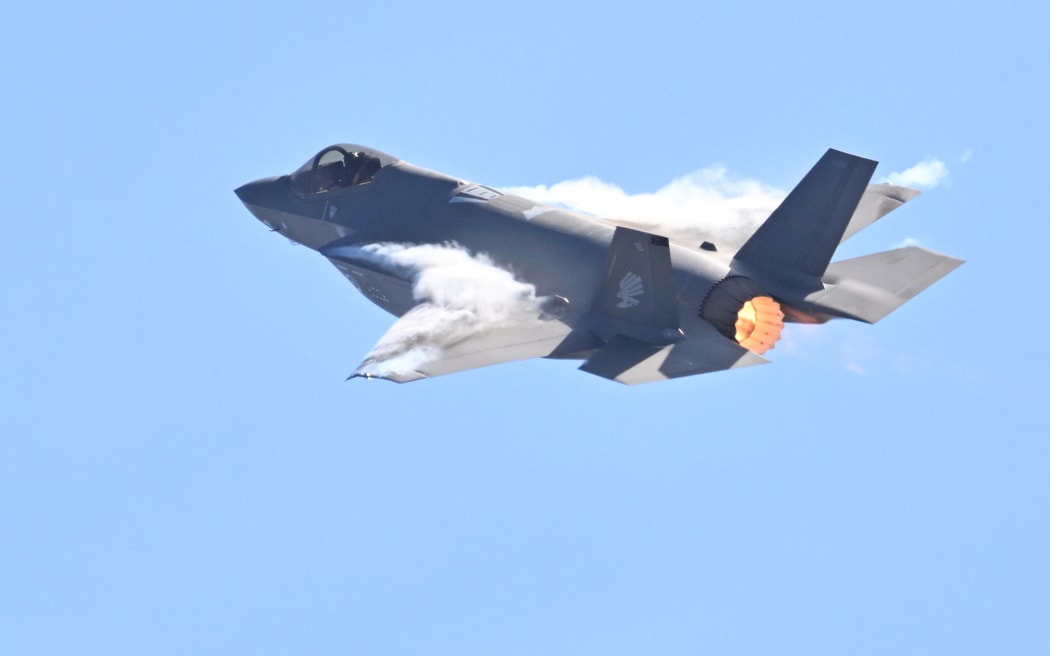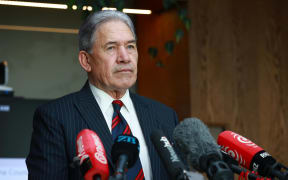
A Royal Australian Air Force F-35A Lightning jet fighter performs an aerial display during a defence expo in 2023. Photo: AFP / Paul Crock
An Australian think-tank report on AUKUS Pillar Two says the military pact may "crush" the defence industry across the Tasman due to the United States' advantages.
Pillar Two is a security pact led by the US, Australia and UK to share advanced military technology.
New Zealand was considering the benefits of joining it, though the government said it was early days, and despite pages and pages of official documents going back over a year discussing Pillar Two were mostly blanked out.
- Read more: Have NZers been misled about AUKUS?
- NZ is reviving the ANZAC alliance - joining AUKUS is the logical next step
- Don't 'mistake' Pacific leaders' 'quietness' on AUKUS as support for NZ's position - expert
The report hailed the "generational" opportunity under AUKUS but warned that the funding gap was glaring, when the US put $NZ240 billion a year into defence research and development.
Under AUKUS, the US was moving to lower its barriers on defence trade, so Australian and British firms could import its military technology without needing licences.
The institute questioned if Australia would be able to exploit that.
"Public funding of early-stage R&D is probably the single biggest factor that's made the US defence industry what it is today. Coupled with the bleeding-edge capability being developed in the commercial sector, it's the most glaring gap in Australia's defence industrial strategy."
It foreshadowed "rapid regulatory reform" to realise the benefits of Pillar Two.
The defence industry had weaknesses and "the government must therefore play an outsized role in jump-starting growth".
The institute recommended looking to what the US was doing, and aligning with it.
"Urgent investment is needed in collaborative associated infrastructure, information technology and cybersecurity.
"Defence must subsidise joint facilities where businesses can work and collaborate in a classified environment [though] Australia shouldn't wholly adopt the US system."
Pillar Two was focused on eight technologies:
- Undersea warfare capabilities
- quantum technologies
- artificial intelligence
- "advanced cyber"
- hypersonic and counter-hypersonic capabilities
- electronic warfare
- "innovation"
- information sharing.
The world's fledgling quantum warfare market was forecast to grow in value from hundreds of millions of dollars to multi-billions in a few years.
AUKUS had a quantum arrangement (AQuA), which a New Zealand government briefing a year ago said "will initially centre on delivering quantum technologies for positioning, navigation and timing; experimentation is expected to begin over the next two to three years".
Such experimentation had already begun: Sydney University of Technology was involved in multi-million dollar projects to assess quantum computing algorithms in a programme led by US Defence Advanced Research Projects Agency (DARPA) and involving huge defence contractor Boeing.
The speed of quantum computers was being held out as a boon for warfare strategy, cryptography and collecting intelligence.
Earlier this month, Foreign Minister Winston Peters said he was still trying to find out what Pillar Two was about.
South Korea was ahead on that, and wanted to join.
There was a lot of information about Pillar Two in official documents going back over a year. Some of the few parts not blanked out discussed Pillar Two creating "potential openings for collaboration with the New Zealand defence industry and adjacent technology companies" and "areas where New Zealand may have relevant niche expertise".
One page of one document was given over to discussing the "relationship implications" of Pillar Two.
Another section discussed the "relationship" between Pillar Two and AUKUS Pillar One.
But both of these discussions were entirely blanked out.
"Public commentary has identified Pillar 2 as also covering some areas on which New Zealand intelligence agencies are already very well-connected with the three AUKUS members."
New Zealand already engaged in a technical cooperation programme with its Five Eyes partners - Canada, plus the AUKUS Pillar One triumvirate.







